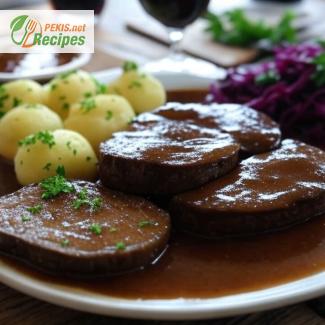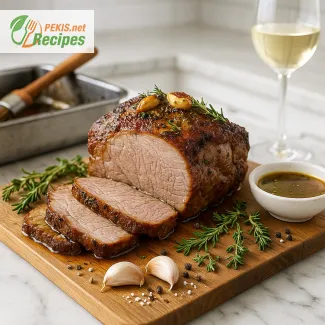
Sauerbraten is a dish that embodies the rich culinary tradition of Germany, celebrated for its perfect balance of tender, marinated beef and a deeply flavorful, sweet-and-sour sauce. This iconic dish is much more than a recipe; it is a symbol of hospitality and time-honored cooking techniques that have been passed down through generations. Whether served during festive gatherings or as a comforting family meal, Sauerbraten continues to captivate food enthusiasts with its complex flavors and melt-in-your-mouth texture.
The Origins of Sauerbraten
Sauerbraten has roots dating back to medieval Germany, where it was originally crafted as a way to preserve meat before the advent of refrigeration. Marinating meat in a mixture of vinegar, wine, and spices was a practical technique, but over time, the recipe evolved into a dish that is cherished for its unique flavor profile. Its name, derived from the German words "sauer" (sour) and "braten" (roast), perfectly encapsulates the dish’s essence.
Regional variations add to Sauerbraten's charm, with recipes differing from one part of Germany to another. In the Rhineland, for example, it is often enriched with raisins and a hint of sweetness, while other regions focus on a more tangy and robust flavor. Regardless of the variation, Sauerbraten remains a quintessential representation of German culinary heritage.
The Flavor That Defines Sauerbraten
At the heart of Sauerbraten lies the marinade, which is key to its distinct taste. Made with a harmonious blend of red wine, vinegar, onions, carrots, and aromatic spices, the marinade not only tenderizes the meat but also infuses it with layers of complex flavors. The result is a piece of beef so tender that it almost falls apart when sliced, bursting with savory, tangy, and slightly sweet notes.
The sauce, created from the cooking juices, vegetables, and seasonings, is a true testament to slow cooking. It is often enriched with Lebkuchen (spiced gingerbread) or a touch of sugar beet syrup, adding depth and a subtle sweetness that balances the dish’s acidity. This sauce, velvety and rich, is what makes Sauerbraten unforgettable.
A Dish for All Occasions
While Sauerbraten is often associated with special occasions, its adaptability makes it suitable for any gathering. It is the centerpiece of festive meals during holidays such as Christmas, where its warm and hearty flavors perfectly complement the season. However, its comforting nature also makes it an ideal choice for a leisurely Sunday family dinner.
Paired with traditional German side dishes like potato dumplings, spätzle, or red cabbage, Sauerbraten creates a meal that is both satisfying and elegant. The interplay of textures and flavors—from the tender beef to the silky sauce and the earthy accompaniments—makes every bite an experience to savor.
Health Benefits and Nutritional Highlights
Sauerbraten is not only delicious but also offers nutritional benefits. The slow-cooked beef is a rich source of protein, iron, and vitamin B12, all of which are essential for maintaining energy levels and supporting the body’s overall health. The addition of vegetables like carrots and onions contributes dietary fiber, vitamins, and antioxidants that promote digestion and boost the immune system.
For those concerned about dietary restrictions, the recipe can be easily adapted. Gluten-free versions of the sauce can be made by substituting traditional Lebkuchen with gluten-free alternatives or thickening the sauce with cornstarch.
Culinary Creativity and Adaptations
One of the most appealing aspects of Sauerbraten is its versatility. While the traditional recipe is iconic, there is plenty of room for personal creativity.
- Wine Variations: Swap red wine for white wine or even apple cider to create a lighter, fruitier flavor profile.
- Herbal Enhancements: Add fresh herbs like rosemary or thyme to the marinade for a unique aromatic twist.
- Sweet Touch: Incorporate dried fruits such as apricots or cranberries for a burst of sweetness that pairs beautifully with the tangy marinade.
Even the choice of meat can be adapted. While beef is traditional, options like pork, venison, or even lamb can be used to bring a new dimension to the dish. Each type of meat brings its own flavor characteristics, ensuring that no two Sauerbraten experiences are exactly the same.
A Timeless Classic Worth Celebrating
Few dishes can rival Sauerbraten in terms of its depth of flavor, cultural significance, and universal appeal. It is a dish that invites both nostalgia and innovation, allowing cooks to honor tradition while experimenting with modern twists. Whether you are preparing it for the first time or revisiting a beloved family recipe, Sauerbraten promises a culinary journey that delights the senses and warms the heart.
Take the time to savor the process of making Sauerbraten—it’s not just a meal, but an experience that brings people together around the table, celebrating the rich traditions of German cuisine.
- Prepare the marinade: Combine red wine, vinegar, and water in a large bowl. Add sliced onions, carrots, leek, bay leaves, juniper berries, black peppercorns, cloves, and salt. Mix well.
- Marinate the meat: Place the beef in the marinade, ensuring it is fully submerged. Cover the bowl with cling film and refrigerate for 3 days, turning the meat daily.
- Remove the meat: Take the beef out of the marinade and pat it dry with kitchen paper. Strain the marinade, keeping the liquid and vegetables separate.
- Sear the meat: Heat the vegetable oil in a large Dutch oven. Sear the beef on all sides until well-browned, then set it aside.
- Cook the vegetables: Add the strained vegetables to the pot and sauté until slightly caramelized. Sprinkle the flour over the vegetables and stir to coat.
- Begin braising: Return the beef to the pot, pour in the strained marinade and beef broth. Bring to a simmer, then cover and transfer to an oven preheated to 160°C (320°F). Cook for 2.5 hours.
- Make the sauce: Remove the beef from the pot and keep warm. Strain the cooking liquid and return it to the pot. Add the gingerbread or brown sugar, then simmer until the sauce thickens.
- Serve: Slice the beef and arrange it on a plate. Drizzle the sauce over the slices and serve with traditional sides like potato dumplings, spätzle, or red cabbage.
Tips and Adjustments to Enhance Your Sauerbraten Recipe
The Sauerbraten is a traditional dish with a rich and complex flavor profile. Its preparation method, ingredients, and slow cooking make it a true culinary gem. However, even the most iconic recipes can be customized and adapted to suit different tastes, dietary needs, and regional preferences. Below, you will find detailed suggestions on how to adjust this recipe and how these changes can influence the final result.
Choosing the Right Meat
The choice of meat is fundamental to the success of Sauerbraten. While beef shoulder or rump is the traditional option, other types of meat can provide unique flavors and textures:
- Venison or game meat: These meats add a more intense, earthy flavor to the dish, pairing beautifully with the sweet and tangy marinade.
- Pork shoulder or loin: Offers a milder, sweeter taste. The texture is slightly softer and works well for those who prefer less robust flavors.
- Chicken or turkey: A leaner option for a lighter version of Sauerbraten. While it won’t be as rich as the traditional version, the marinade still infuses these meats with bold flavors.
Modifying the Marinade
The marinade is the essence of Sauerbraten, responsible for tenderizing the meat and imparting its distinctive flavor. Making small changes to the marinade can lead to interesting results:
- Changing the type of wine:
- Red wine creates a deep, rich base.
- White wine results in a lighter, fruitier flavor.
- Apple cider adds a subtle sweetness and complements pork or poultry.
- Adjusting the vinegar:
- Red wine vinegar provides a classic tang.
- Balsamic vinegar adds sweetness and depth, balancing the sour notes.
- Experimenting with spices:
- Add a touch of cinnamon or nutmeg for a warm, aromatic twist.
- Increase the number of cloves for a bolder, spicier profile.
Enhancing the Sauce
The sauce is often considered the highlight of Sauerbraten. Adjustments can make it more personalized:
- Using different thickeners:
- Substitute gingerbread with crushed cookies or breadcrumbs for a thicker, sweeter sauce.
- Opt for gluten-free flour or cornstarch for a lighter, allergen-friendly version.
- Incorporating fruits:
- Add a handful of raisins, dried cranberries, or apricots for natural sweetness and texture.
- Customizing sweetness:
- Use honey, maple syrup, or beet syrup instead of sugar to control the level and type of sweetness.
Experimenting with Side Dishes
Traditional side dishes like potato dumplings and red cabbage complement Sauerbraten perfectly, but alternative pairings can also elevate the dish:
- Polenta: A creamy and versatile option that absorbs the sauce beautifully.
- Mashed sweet potatoes: Adds natural sweetness, which balances the tangy flavors of the dish.
- Seasonal vegetables: Roasted root vegetables, such as parsnips or turnips, add texture and enhance the earthy notes.
Dietary and Regional Adaptations
Sauerbraten is versatile enough to accommodate dietary restrictions and regional preferences:
- Gluten-free adaptation: Use gluten-free flour for the sauce and replace gingerbread with gluten-free cookies. This version retains the traditional flavor without compromising dietary needs.
- Vegetarian alternative: Replace the meat with hearty vegetables such as portobello mushrooms or jackfruit. Use vegetable broth instead of beef broth, and marinate the vegetables for 1–2 days to enhance their flavor.
- Health-conscious modifications: Trim visible fat from the meat and reduce the amount of oil during searing to lower the fat content.
Exploring Regional Twists
Different regions in Germany have unique takes on Sauerbraten:
- Rhineland Sauerbraten: Incorporates raisins or currants into the sauce for a sweeter flavor.
- Franconian version: Features a more robust sauce with a stronger emphasis on vinegar and savory spices.
- Swabian style: Often includes a pinch of nutmeg and serves Sauerbraten with spaetzle.
How Adjustments Affect Flavor
Every modification has a direct impact on the final dish:
- Sweeter marinades or sauces: Create a more approachable dish, especially for those who prefer milder, less tangy flavors.
- Spice-heavy marinades: Add depth and warmth, making the dish more aromatic and suitable for festive occasions.
- Lighter side dishes: Balance the richness of Sauerbraten, offering a more modern and health-conscious meal.
Sauerbraten is a dish steeped in tradition but is flexible enough to embrace innovation. Whether you wish to explore regional variations, accommodate dietary restrictions, or simply experiment with new flavors, this dish provides a canvas for creativity. Adjustments to the meat, marinade, sauce, and accompaniments can transform Sauerbraten into a meal tailored to your preferences while still preserving its rich heritage.
- Contains gluten (gingerbread, flour).
Substitution tips:
- Gluten-free: Use gluten-free flour for thickening the sauce and replace gingerbread with gluten-free cookies or omit it entirely.
- Vegetarian alternative: Substitute beef with large portobello mushrooms or seitan and use vegetable broth instead of beef broth.
- Iron: Essential for oxygen transport in the blood.
- Vitamin B12: Supports red blood cell formation and nerve function.
- Potassium: Maintains healthy heart function and electrolyte balance.
- Beta-carotene: Found in carrots, boosts immune health.
- Polyphenols: From red wine, provide anti-inflammatory benefits.





